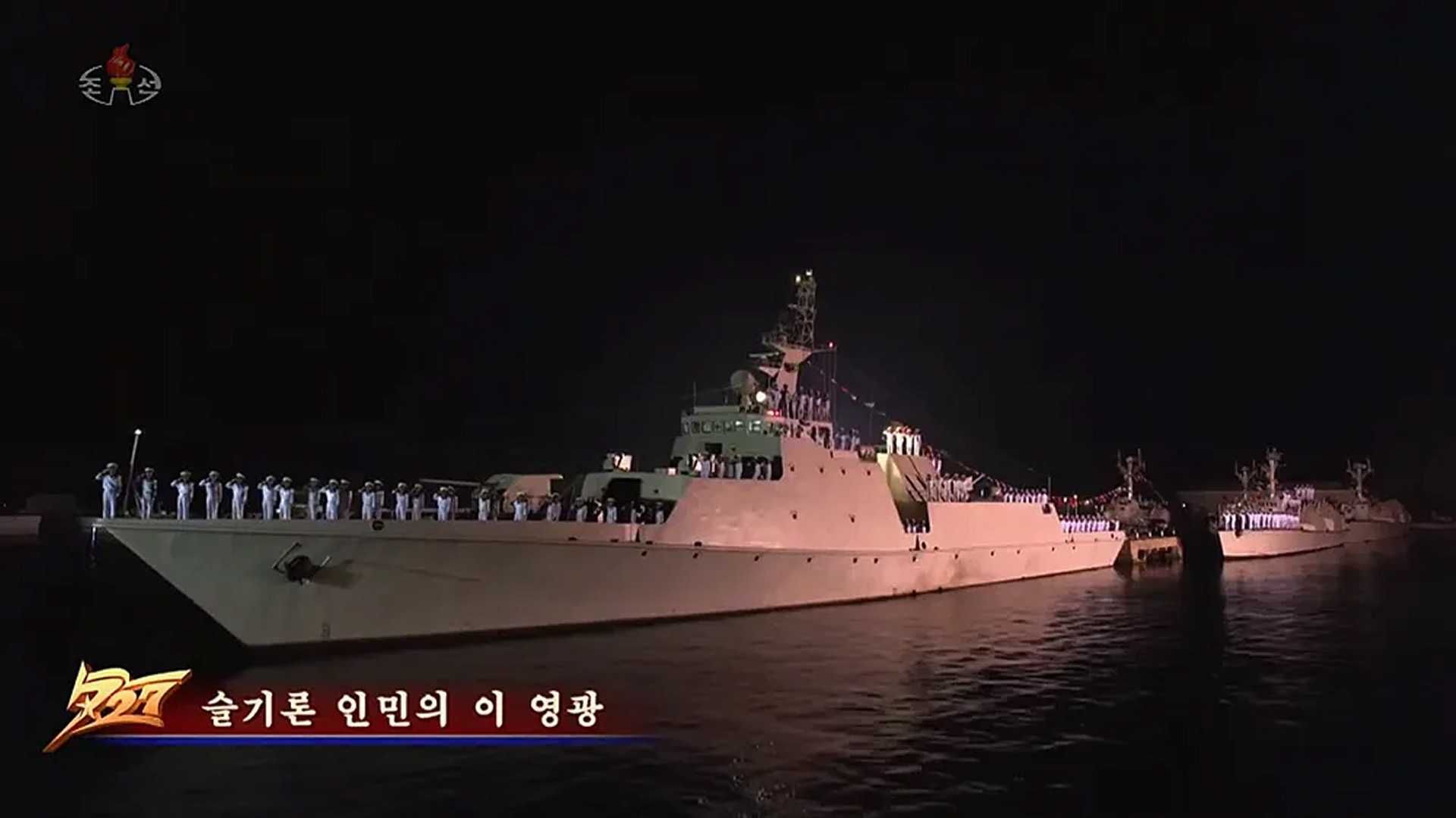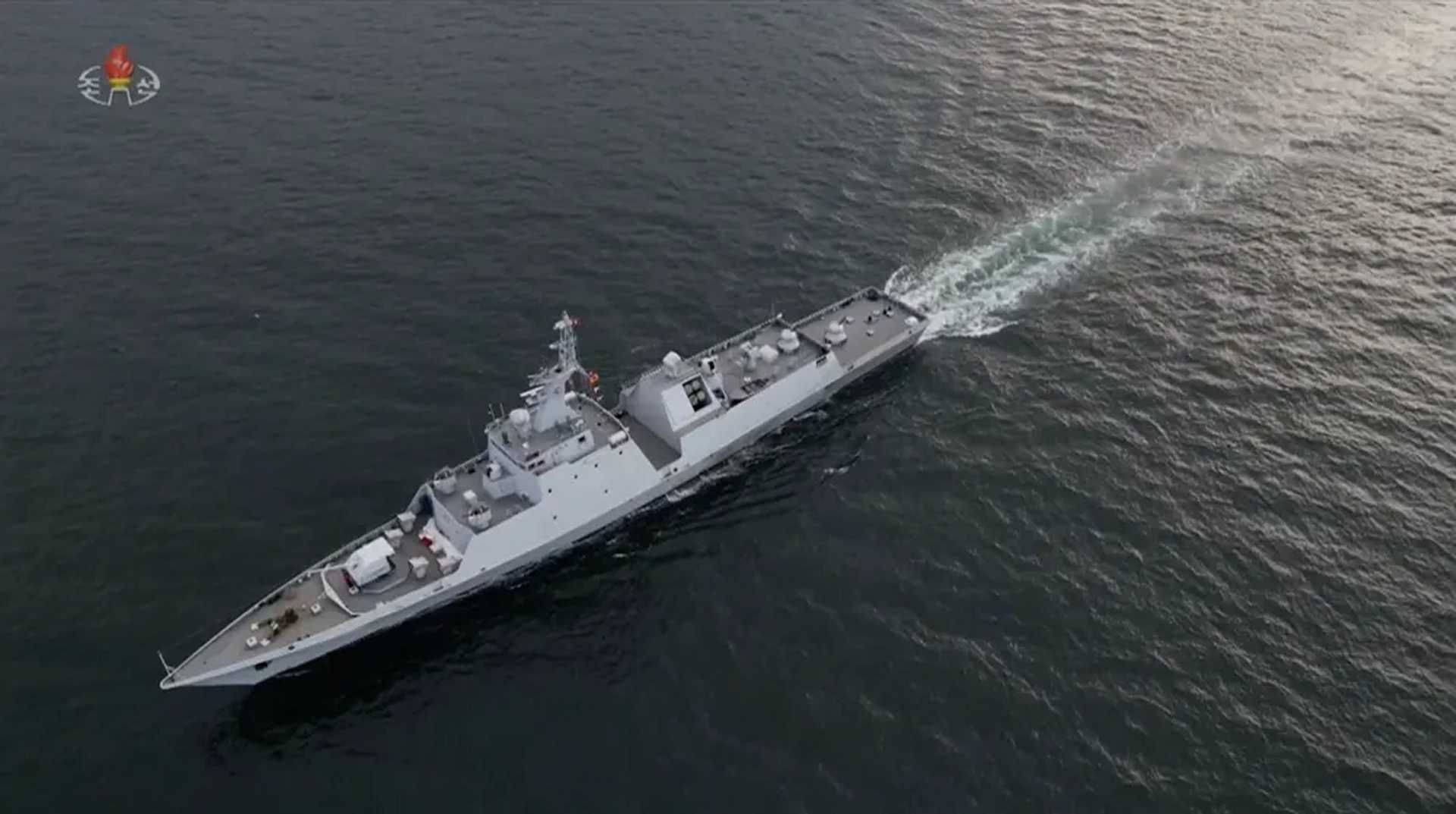Breaking News
North Korea to soon introduce its biggest warship to date as a possible new class of guided missile frigate.
As reported by the CSIS on April 8, 2025, satellite imagery acquired between late March and early April 2025 confirms that a large new North Korean warship under construction at Nampho Port has likely exited its construction hall and is currently undergoing outfitting in a floating drydock adjacent to a newly refurbished quay. The ship, which is covered in camouflage netting and measures approximately 140 to 144 meters in length, is now positioned within a 120-meter drydock. This would make it the largest surface combatant ever constructed by the Korean People’s Navy (KPN). Its relocation and current status suggest that North Korea is in the final phase of completing the ship’s internal systems and installing equipment before its transfer to the Navy.
Follow Army Recognition on Google News at this link

The ship, which is covered in camouflage netting and measures approximately 140 to 144 meters in length, is now the largest surface combatant ever constructed by the Korean People’s Navy (KPN). (Picture source: CNN/Maxar via Twitter/The Global Observer)
Construction of the warship began in May 2024 at Nampho, North Korea’s principal west coast port and the headquarters of the West Sea Fleet. Initial activity was noted at a preexisting ship repair site, where a 170-meter-long and 30-meter-wide slipway was built. Shortly thereafter, hull sections were positioned on the slipway, and a construction hall was erected around them. This structure was completed by the end of 2024, obstructing satellite visibility for several months. The slipway’s dimensions have led analysts to assess that the facility is intended for ships significantly larger than those previously constructed by North Korea.
Satellite imagery from March 23 to 26, 2025, shows that the floating drydock was maneuvered into place in front of the construction hall and aligned with its launch rails. By March 26, the drydock—now containing the vessel—had been relocated to the western end of the quay, and by March 30, it had been repositioned to the eastern end, where it remained on April 6. The vessel is still largely obscured by camouflage netting, preventing a full assessment of its configuration and onboard systems. However, the forward section is partially exposed, revealing a crane. The crane’s specific role is unclear, though it may be involved in work related to the anchor winch, sonar dome, or foredeck fittings.
The estimated length of the ship closely matches that of a vessel observed during Kim Jong-un’s visit to the construction hall on March 8, 2025, as reported by North Korean state media. Analysts believe the ship now undergoing outfitting is the same as the one inspected by the North Korean leader. Based on the shape of the superstructure and estimated dimensions, the vessel is considered to be a guided missile frigate (FFG), and possibly a helicopter-capable version (FFGH) if it includes a hangar. The ship is believed to feature a helideck and possibly a hangar, although the presence of the latter cannot be confirmed due to the camouflage. If confirmed, this would make it only the second North Korean warship designed to operate a helicopter.
It remains unclear whether this vessel is a new class or a variant of the existing Amnok- or Duman-class frigates. Previous ships have varied significantly in configuration, incorporating systems ranging from Soviet-era radar to newer missile launchers, with some featuring reduced radar cross-section designs and locally produced 76mm or 100mm naval guns. The vessel at Nampho may also serve as a prototype for a new class of surface combatants intended to operate alongside nuclear-powered submarines—another program North Korea has stated it is pursuing. With a likely displacement of over 3,000 tons, the ship would be twice the size of the Amnok-class and may be intended for a broader strategic role in the West Sea.

Despite its limited size and outdated electronic systems, the North Korean Yalu-class is notable for being heavily armed relative to similar tonnage warships. (Picture source: North Korean MoD)
North Korea reported to the International Maritime Organization (IMO) in 2023 that it was constructing two Nampo-class helicopter-capable corvettes, sometimes designated as frigates. The current vessel may be one of those listed. If confirmed, it would represent only the second instance in which North Korea has attempted to field a helicopter-operable warship. The first was the Soho-class frigate, which has since been retired. An April 8, 2025, analysis by the Center for Strategic and International Studies (CSIS) supports the classification of the new vessel as an FFG, potentially capable of engaging in anti-air, anti-ship, and anti-submarine operations using guided missiles. To date, there is no confirmation that the ship is equipped with vertical launch systems, or cruise missiles such as the Kh-35-derived Geumseong-3, the Hwasal, or the Arrow-2, or that it carries anti-submarine rockets. However, a close-up satellite image from April 6, 2025, captured by Maxar, shows equipment being installed on the ship, and its shape closely resembles the vessel shown in North Korean state media in both 2023 and 2025.
Recent assessments have highlighted that the vessel’s size and configuration are similar to those of modern frigates such as the U.S. Navy’s Constellation-class. These analyses, based on Maxar Technologies satellite imagery, suggest the possible presence of vertical launch systems and active electronically scanned array (AESA) radars—capabilities not previously identified on North Korean warships. Nonetheless, doubts remain as to whether North Korea can fully integrate such systems. Experts note that while hull construction is an important milestone, it is the integration of sensors, combat systems, propulsion, and weapons that defines a warship’s effectiveness. Carl Schuster, a former U.S. Navy captain, has stated that the vessel is unlikely to begin sea trials for at least another year, as multiple critical systems are still absent.
Activity continues around the construction hall. On March 30, the roof appeared partially retracted, possibly for ventilation or the delivery of additional components. A gantry crane was positioned above the opening. By April 6, the crane had shifted toward the hall’s southern end, further revealing its interior. A floating crane and two barges were moored nearby, indicating ongoing material transfers. This may signal that a second ship of the same class is either under construction or in preparation. Additional support infrastructure near the hall is progressing. Roofing work has been completed on the largest adjacent building, and roof trusses have been added to another building as of March 30. Moreover, the petroleum, oil, and lubricants (POL) storage area has expanded: in addition to two previously identified tank bases, three more have been constructed since January 2025.
The development of this ship is occurring within the broader context of North Korea’s naval modernization efforts. Nampho Shipyard has a history of producing both civilian and military vessels, including the two Amnok-class missile corvettes—currently among the most heavily armed platforms in the KPN. These corvettes are approximately 80 meters long and equipped with cruise missiles, close-in weapon systems (CIWS), and short-range air defense missiles. The new ship is substantially larger and, if equipped with modern systems, could represent a new category within the North Korean surface fleet.

The Yalu-class frigate, also known as the Apnok-class within North Korea, represents one of the principal surface combatants of the Korean People's Navy (KPN). (Picture source: North Korean media)
Multiple sources have suggested that the vessel may feature vertical missile launch systems and advanced sensors. Beyond Parallel, a project run by CSIS, reported that two tower cranes and outfitting supplies were present near the vessel as of early April 2025. These observations support the assessment that the ship is currently in the “fitting-out” phase, during which internal systems are completed, equipment is installed, and the vessel is prepared for naval service.
Elsewhere, new shipyards have also been identified in Sinpo and Chongjin. According to analyst reports, these locations are producing additional submarines and surface combatants. North Korea is continuing work on the Kim Gun-ok Hero-class submarine, believed to be equipped with submarine-launched ballistic missile (SLBM) capabilities. The construction of the frigate at Nampho is also being viewed in relation to increasing military-technical cooperation between North Korea and Russia. Ukrainian intelligence has reported that Russia has transferred submarine missile-launch technology to North Korea. Some experts have speculated that Russian assistance may also extend to surface warship construction, although this remains unconfirmed by independent sources.
According to the 2014 South Korean Defense White Paper, the Korean People’s Navy operates approximately 750 surface vessels and 70 submarines. However, the majority of these are small, aging platforms such as torpedo boats and fast attack craft. While the fleet is numerically large, its overall effectiveness is limited by aging systems, poor maintenance, and technological shortfalls. The KPN is classified as a green-water navy, with limited operational capacity beyond coastal areas. The construction of larger warships, including the new guided missile frigate at Nampho, may reflect an effort to enhance regional power projection, particularly in the West Sea.
Nevertheless, analysts remain cautious. Although the vessel has a contemporary profile, it still incorporates older systems, such as the MR-104 “Drum Tilt” radar, and appears to lack advanced electronics. North Korea continues to face logistical constraints, including fuel shortages and limited training opportunities, which could affect the ship’s future operational performance. The KPN has historically relied on camouflage, deception, and asymmetric strategies, and the addition of a single large surface vessel, by itself, does not signify a transformation in North Korea’s naval posture.


























